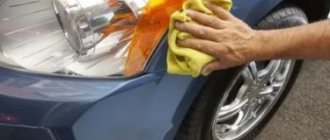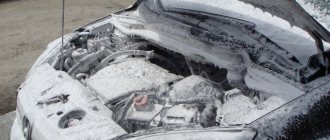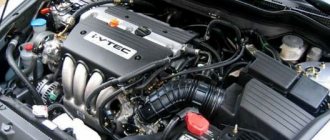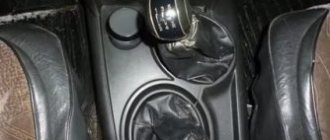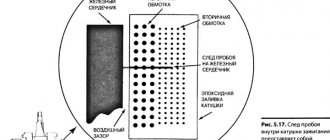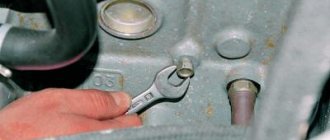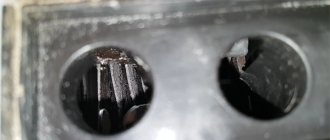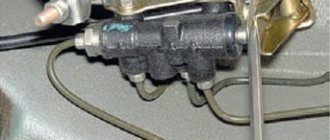Long-term storage of a car requires a competent preservation procedure, which includes draining technical fluids or replacing them with suitable compounds. If this is not done, then the working fluids lose their properties, rubber products dry out, parts become corroded, etc. It is quite obvious that an unprepared car will need to be restored after 2-3 years of parking.
A vehicle that has been idle for a long time (6 months or more), which has not been prepared in advance for such parking and has not undergone a preservation process, may require some preparation before starting the engine. Additionally, it is necessary to take into account the parking time, seasonality and conditions in which a particular vehicle is located.
Wake up the battery
Do not start the engine immediately. The battery needs to be prepared. Long downtime is not good for the battery, especially if it has been working on the machine for more than five years. The battery loses charge and is not always ready to instantly replenish the load from many electronic systems. As a result, errors occur that affect the operation of the electronics. Therefore, you must first cheer up the battery. To do this, before starting the engine, you can turn on the high beam headlights for a couple of seconds by pulling the steering column lever towards you. Three or four blinks will trigger chemical processes in the battery that will allow the battery to prepare for operation.
Article on the topic Freeze in place. How does prolonged downtime affect a car? Next, turn the ignition key in the lock and leave it in the second position for a few seconds. The fuel pump will pump gasoline, and the electronics will diagnose the performance of the machine’s systems, set the correct mixture, after which the power unit can be started. If the car is started with a button, then to activate the ignition, press it twice without pressing the brake pedal with your foot.
Consequences of a car sitting idle for a long time
It should be immediately agreed that the term “long downtime” is a relative concept. Therefore, we will separately consider starting the engine after different periods of parking, including long-term storage of the car. After parking the car for a long time, the following negative factors may appear:
- Battery discharge.
- Oxidized contacts.
- The piston rings are stuck in the pistons. Air penetration into the power supply system of diesel power units.
- Evaporation of gasoline from the carburetor body, or draining of fuel from the tank.
In addition to these well-known situations, you can also see the consequences of animal life. Even drivers who constantly use their cars may find that hoses or wires have been chewed by rats. There is a possibility that after such parking the car will not start for a long time.
The oil must be pumped
It is not recommended to drive immediately after the start. Over several weeks of inactivity, the oil has completely drained from the working surfaces of the friction pairs into the crankcase, and it takes time for the oil pump to pump it again through the complex labyrinths of the lubrication system. If you start accelerating in the first second and immediately hit the road, and even apply the gas to feel the power of the engine, then there is a high chance of ruining it through inept actions. Scores may appear on the cylinder walls. This occurs when the piston rings break through the oil film and touch the cylinder lining under load. Scratches appear through which oil seeps into the chambers, burns there and is released through the exhaust system into the atmosphere in the form of dark or bluish smoke. This is a death sentence for the motor. Scuffs can be repaired only by grinding the walls and re-honing.
To avoid scoring, you need to wait about 3 minutes while the oil pump passes 4 liters of oil through the lubrication system and filters out the caked sediment. Then you can slowly set off on your journey.
Disservice. What car systems reduce engine life? More details
Checking technical fluids
It is also necessary to carefully check the level and condition of all technical fluids: engine oil, brake fluid, power steering fluid (power steering), transmission oil level (if possible), cooling system coolant level in the expansion tank. All fluids must be filled in full before starting. A decrease in level or an empty tank will indicate a malfunction in the form of leaking pipes, gaskets, seals, etc. It is worth checking the fluids most closely in the most important components (engine oil, cooling system, fuel system).
Engine oil condition
Motor oil tends to age not only with mileage, but also with time. The shelf life of the lubricant that is poured into the engine is very limited and is about 12 months. Moreover, if the engine is in operation, the additive package tends to mix with the base. When a car sits for a long time, the additives settle and the oil simply separates. For this reason, it is necessary to evaluate the condition of the lubricant.
If the oil is very thick, black, and contains impurities and debris, then it is better not to start the engine. This oil is drained, after which the flushing composition is poured. Next, you can add fresh lubricant and replace the oil filter.
Fuel in tank
Gasoline or diesel fuel tends to accumulate moisture (condensation). If the car is prepared for parking in advance, then the tank is 2/3 filled with high-quality fuel, which must be drained before starting. As for unprepared vehicles, there is a high probability that there will be spoiled fuel in the fuel tank, which must be drained.
Coolant
To check, just unscrew the cap of the expansion tank and assess the condition of the coolant. If the level is within acceptable limits, there are no visible “flakes” or other contaminants, then you can drive several kilometers on such a liquid, carefully monitoring the engine temperature. Next, the fluid will need to be changed, after flushing the cooling system.
Brake fluid
One of the properties of brake fluid is hygroscopicity, which means the accumulation of moisture. Under normal conditions, brake fluid is changed once every two years. If the car has been sitting for a long time, then before the first trip the fluid is drained and the brakes need to be bled.
Next, be sure to check the brake pads and brake discs themselves. Loose linings on the pads make them unsuitable for further use.
If the brake discs are covered with rust, then when starting to move, lightly hold your foot on the brake, thus driving several tens of meters. The rust must be removed.
Transmission needs to warm up
When an old car, well over a dozen years old, is equipped with a manual transmission, you need to start the engine after idle time only at neutral speed. If you leave the box in gear and crank the starter with the clutch depressed, there is a high risk that during a month of inactivity the friction discs have become stuck to each other, have not opened, and the transmission will receive a blow from the output shaft of the power unit. Neutral speed will allow you to warm up the engine and gearbox before starting to move, and the clutch discs will open more easily after several repeated presses of the pedal.
An automatic transmission requires a different approach. In the first seconds of engine operation, an additional pump in the transmission also pumps transmission oil through the complex labyrinths of the box. And this requires about two minutes of idling. Therefore, it is necessary to wait until the transmission is in working condition.
What to fill?
First of all, you need to deal with all the liquids remaining in the immobilized car.
No wonder there is a whole system called car preservation - for those who know that they will leave their car for a long time. And this complex, first of all, includes draining much of what was poured into the car, and correctly replacing what does not drain. The comrades who did not preserve the car will do this when restoring it. Oil
. The product, in principle, is long-lasting and can be stored in its original packaging for years without losing its specified properties. However, oil poured into a car has a significantly reduced shelf life. When the unit is running, it is mixed all the time. When the engine is idle, all the additives settle, and the oil itself stratifies. At a minimum, you need to check its condition. It’s safer to drain, rinse, refill and change filters. The article “How to check the engine oil level” can help.
Petrol
. During idle time it is diluted with condensate. During conservation, high-quality fuel is poured, not reaching the maximum by a third. And in any case, this sediment is drained when the car is resuscitated.
Brake fluid
. It is also quite hygroscopic - it absorbs water better than a sponge. In a diluted state, it is not suitable for consumption - drain and replace with fresh one.
Gaskets and hoses:
At a minimum, the oil seals, crankcase seal and wiper pads are checked (even if it’s sunny now, rain can gather quickly). In principle, when not used for a long time, all the rubber bands deteriorate - they dry out and crack. But replacing them en masse will cost a pretty penny. Therefore, replacement of non-vital items is postponed until later. The same goes for hoses - and here the purchase of new ones cannot be pushed into the future. True, the hoses will have to be changed only on those cars whose downtime is longer than 4 years. But it is imperative to check the gas lines and all the corrugation.
Brakes:
The first thing that suffers is the brake discs - they simply rust. However, this is not the biggest problem: their replacement is still far away. It’s just that, after the factory, you need to drive a little, constantly slowing down - unnecessary layers will fall off. Another thing is the brake pads. If you want to live longer, check them carefully. If the linings have separated from the base, they urgently need to be changed.
No jumping
Once you start driving, you should not allow the car to “jump” over bumps. The fact is that the oil in the shock absorbers has also settled, and they require a delicate attitude. If you carefully drive through several potholes and bumps at speeds below 20 km/h and continue to follow the road without strong impacts on uneven surfaces and without swaying on the asphalt waves, the shock absorbers will quickly warm up and after a couple of hundred meters they will be able to handle obstacles painlessly.
Question answer
Do “million dollar cars” really exist? However, during active drive immediately after the start, uneven oil in cold shock absorbers can cause pressure concentration in local areas, which leads to damage to the gaskets. The shock absorber will simply leak.
In general, these actions do not require time and financial resources, but they significantly save car owners money on possible repairs.
Additional checks and preparations
At the initial stage, it is necessary to carefully inspect all gaskets and hoses of the main components. If the car has been standing for up to 3-4 years, then the rubber products may still be rejected by workers.
A longer downtime may mean that the rubber has dried out and cracked. First of all, check the fuel line and cooling system pipes.
We also recommend reading the article on how to start a car using a jump charger. From this article you will learn about the advantages of this solution compared to other methods of starting an engine with a dead battery.
Before starting, it is advisable to change the spark plugs on a gasoline engine, and also inject a small amount of engine oil into the cylinders through the spark plug wells. After this, the engine without spark plugs must be cranked with the starter to remove any remaining oil, and then new spark plugs must be screwed in. For a diesel engine, the procedure is similar, only in this case the glow plugs are changed.

